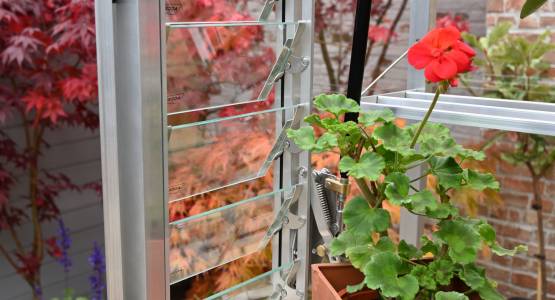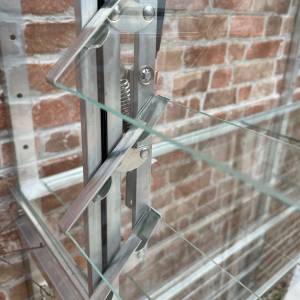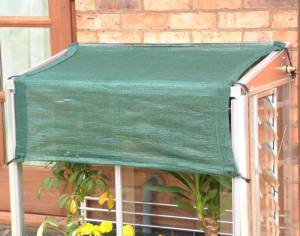Greenhouse Ventilation – A Complete Guide

In the bustling world of greenhouse gardening, ensuring proper ventilation is often overlooked but is crucial for the success of your plants. Ventilation plays a pivotal role in maintaining optimal growing conditions, regulating temperature, humidity, and air circulation. In this comprehensive guide, we’ll delve into the benefits of greenhouse ventilation, explore different ventilation options including roof vents and side vents, discuss the importance of through ventilation, and shed light on the mechanics of automatic louvre vents. We’ll also touch on the importance of circulating fans and greenhouse shading. We will also highlight the consequences of neglecting proper ventilation in your greenhouse.
Benefits of Greenhouse Ventilation
Effective ventilation offers a myriad of benefits for greenhouse growers. It helps regulate temperature and humidity levels, preventing heat buildup and excessive moisture that can lead to fungal diseases and plant stress. Proper air circulation also promotes even distribution of carbon dioxide, essential for photosynthesis, and encourages pollination by helping to disperse pollen. Additionally, ventilation helps control pests and diseases by reducing stagnant air and humidity levels, creating a healthier environment for plants to thrive.
Roof Vents and Side Vents
Roof vents and side vents are two primary methods of ventilating a greenhouse. Roof vents, typically installed at the peak of the greenhouse roof, allow hot air to escape, drawing in cooler air from outside. Side vents, located along the walls of the greenhouse, facilitate cross ventilation, promoting air movement throughout the growing space. Both types of vents can be manually operated or automated for convenience, providing growers with flexibility in managing ventilation according to changing environmental conditions.
Importance of Through Ventilation

Through ventilation, achieved by having both roof and side vents, is essential for creating optimal airflow within the greenhouse. This continuous exchange of air helps prevent pockets of stagnant air and ensures uniform distribution of temperature and humidity throughout the growing area. Through ventilation also minimises the risk of humidity-related issues such as mould and mildew, while promoting healthier plant growth and development.
Automatic Louvre Vents
Automatic louvre vents are a popular choice for greenhouse ventilation, offering hands-free operation and precise control over airflow. These vents consist of horizontal slats that can be opened or closed automatically based on temperature or humidity settings. A vent opener filled with plant oil is connected to the opener. As the plant oil warms it expands, pushing down on the opening lever. As temperatures cool, the oil contracts and the springs on the vent cause it to close. When temperatures rise, the vents open to allow hot air to escape, and close again when temperatures cool, maintaining optimal growing conditions. Automatic louvre vents are an efficient and convenient solution for greenhouse growers, especially during periods of fluctuating weather.
Circulating Fans

In addition to vents, in larger greenhouses, circulating fans are an invaluable tool for improving air circulation within the greenhouse. By gently circulating air throughout the growing space, fans help distribute heat, humidity, and carbon dioxide more evenly, reducing the risk of hot spots and promoting healthier plant growth. Oscillating fans are particularly effective at creating gentle airflow, while ceiling-mounted fans can help move air vertically, ensuring thorough ventilation from top to bottom.
Greenhouse Shading
Greenhouse shading is another important aspect of managing climate control, particularly during the hot summer months. Shade netting or paint-on glass shading can help reduce the intensity of sunlight, preventing overheating and sunburn damage to plants. Shade netting can be easily installed over the roof or walls of the greenhouse, while paint-on glass shading provides a more permanent solution for reducing solar radiation. Proper shading can significantly improve growing conditions and reduce the need for excessive ventilation to cool the greenhouse.
Consequences of Neglecting Greenhouse Ventilation
Failure to adequately ventilate a greenhouse can have dire consequences for plant health and productivity. Without proper airflow, temperatures can soar to dangerous levels, leading to heat stress, wilting, and even death of plants. High humidity levels can create a breeding ground for fungal diseases such as powdery mildew and botrytis, while stagnant air can attract pests like aphids and whiteflies. Additionally, poor ventilation can hinder pollination, leading to reduced yields and poor fruit set in flowering plants.
Greenhouse Ventilation Conclusions
In conclusion, greenhouse ventilation is a vital aspect of successful gardening, ensuring optimal growing conditions and maximizing plant health and productivity. By understanding the benefits of ventilation and implementing a combination of roof vents, side vents, automatic louvre vents, circulating fans, and greenhouse shading, growers can create a thriving growing environment for their plants. Neglecting ventilation can have serious consequences, underscoring the importance of proper airflow management in greenhouse cultivation.
With these insights, you’ll be well-equipped to take your greenhouse gardening to new heights. Happy growing!
